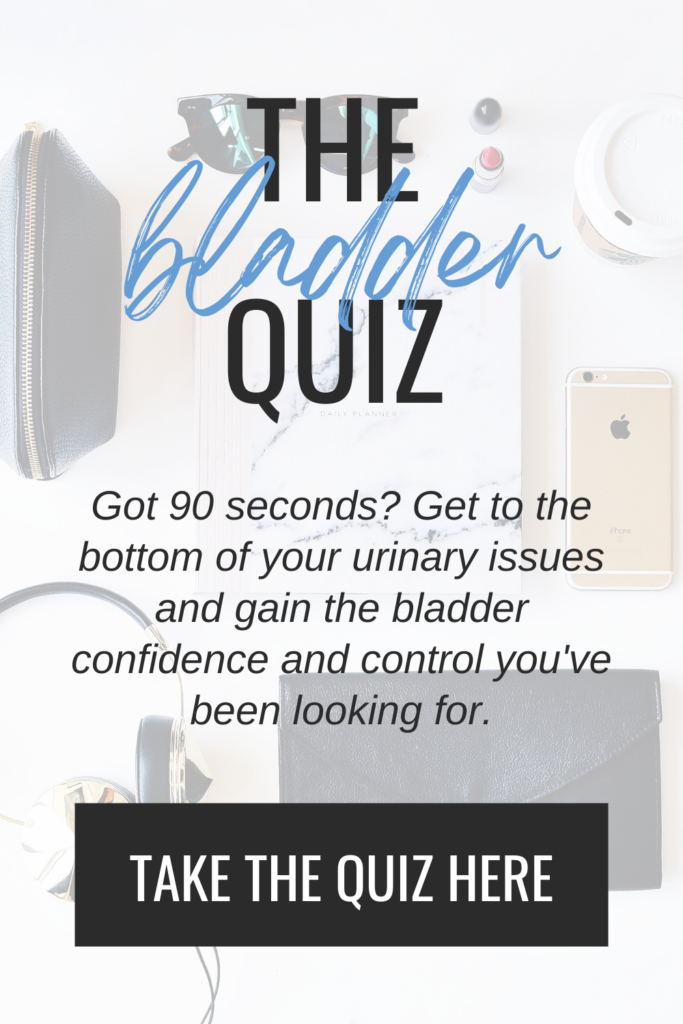Well friend, I’m so happy I could cry! Not only because you’re here in my little corner of the internet (eeeeeeek!…welcome!) but also over the fact that the average woman now knows 1) what the pelvic floor is and 2) that tight pelvic floor muscles are not a good thing. I guess social media might *actually* be good for something after all!
To give a little refresher on the above and ensure that your time spent reading further is a smashing success, let me remind you of a few pelvic health facts every woman should be able to rattle off as easily (and excitedly) as the Spice World soundtrack lyrics –
- The pelvic floor is a sling of muscles that sit in the bottom of the pelvis. Their main roles are bowel & bladder sphincter control, sexual function & reproduction, and provide stability & support to the spine, hips, and pelvis.
- Tense does not mean strong when it comes to the pelvic floor, or any muscle in the body, despite past praises for a “tight vagina”. Tense pelvic floor muscles are painful, weak, and dysfunctional, and often the culprit behind many pelvic health concerns.
- Kegels (or pelvic floor muscle contractions) are not the answer to all pelvic health problems. In fact, they are frequently the last thing I prescribe to my patients.
Because nearly every woman has pelvic floor tightness and its frustrating effects, I find myself sharing how it starts, signs & symptoms, and how to fix it at any and every opportunity. It’s what comes up most in my in-person clinic and during virtual pelvic health consults, and my free guide about how to release pelvic floor tension is my most frequently downloaded resource. If I had a stage, microphone, and captive audience, [this] is the stuff I would be talkin’ about.
RELATED POST: 19 Reasons You Have a Tight Pelvic Floor (Plus…What to Do About It)
RELATED POST: My Daily Pelvic Floor Relaxation Routine & Why You Might Want to Try It Too
I pride myself in a “less is more” approach to pelvic health, because we’re all busy & ambitious & don’t have a second to spare. So the stretching exercises, postural awareness, “mini kegel-let it go” method (iykyk), and breathing technique I preach on repeat (and share in that free guide I mentioned earlier *wink wink*)…they’re not only intentionally realistic, relatable, and real-life approved, but they get results. Can I get an amen!?.
RELATED POST: The Importance (& Power) of Posture for Pelvic Health
RELATED POST: Easy & Impactful Ways to Use Your Time Confetti To Improve Your Pelvic Floor Health
Let’s just blame stress
There are so many potential causes for pelvic floor (and full body) muscle tension, but at the end of the day, it all boils down to stress – physical, mental, and emotional stress. From chronic pain or a history of trauma to prolonged standing, work deadlines, and potty training a toddler…as humans we hold those stressors in our systems, and the body ultimately keeps the score. (PS – “The Body Keeps the Score” by Dr. Van Der Kolk is a must-read if this resonates with you.) While not all stressors are avoidable, we can control how they manifest in our bodies, and releasing that tightness is your ticket to true transformation.
RELATED POST: 3 [Shocking] Ways Your Pelvic Floor Responds to Stress
RELATED POST: Mantras, Meditation, & 14 Other Kiiiiiinda Crunchy Practices for Stress Relief
Ready…set…release…aaahhhhh
Soooooo…what if I told you relaxing your pelvic floor muscles could be even easier? What if you don’t need to think or even know about “down there” to begin decreasing its tension? Because the body is all connected, both anatomically and energetically, you can harness the power of other, more accessible parts to purposefully and positively affect the pelvic floor. Adios excuses, hellooooooooo relief! I can’t wait for you to experience the magic of full body relaxation for pelvic health.
Now that you know the effects of stress (in every form of the word) on the body and how that tension can manifest anywhere and everywhere (especially the pelvic floor), aaaaand that pelvic floor tightness is not a good thing, it’s time to let that ‘ish go. Specifically and purposefully relaxing the pelvic floor is a necessary skill (again…have you downloaded that free guide!?), but if you’re just not there yet, releasing tension in these six other body parts is the next best place to start.
JAW
As a baby forms in its mother’s womb, one of the first things that develops is called the dural tube, a structure that runs from the skull to the pelvis. The tissue ultimately attaches the mouth to the bowel and bladder systems and creates the spinal connection from the head to the tailbone (aka jaw and pelvic floor muscles). Fun fact – when we talk in a low tone, the pelvic floor lengthens; a high tone causes the pelvic floor to contract. Therefore, mindfully unclenching the jaw is a great way to begin releasing pelvic floor tension.
SHOULDERS
The shoulder bone is connected to the shoulder blade. The shoulder blade is connected to the ribcage. The ribcage is connected to the spine. And the spine is connected to the pelvis. Beyond the clenched jaw, the body’s second most common reaction to stress is to elevate the shoulders towards the ears, and…you guessed it!…this constant, chronic raising of the shoulders, even if slight, can result in tight pelvic floor muscles. Dropping the shoulders like you’re sticking your shoulder blades in your back pockets is a step in the right direction to pelvic floor relaxation.
HANDS
I often relate a tight pelvic floor to a clenched fist – if your hand is stuck in a fist, the muscles will become painful, weak, and dysfunctional. While it would be a stretch to say the hands are connected to the pelvic floor, subconsciously holding tension in them promotes a pattern of stress throughout the body that can most definitely make its way to the muscles below. Awareness of what your hands are doing through the day could absolutely help improve pelvic floor muscle tightness.
ABDOMEN
Ooof! As women who have been told our entire lives to suck in our stomachs and squeeze into the smallest jeans possible, this one tends to be the toughest of all. But when we basically hold our breath all day, this chronic muscle tightness, plus constant change of abdominal pressure, forces the pelvic floor to continually contract. I’m not saying to let it all go (because engaging the core is so, so, SO important), but breathing into the belly and allowing it to move out on exhale is necessary for pelvic floor relaxation.
RELATED POST: PS – Deep Core Strengthening Is Easier (& More Essential) Than You Think
GLUTES
A whole new meaning to the term “tight ass”! (Badum-tsssss!) I’m sure it’s no stretch to see that the glutes and pelvic floor are LIT-ER-A-LLY connected, so clenching those cheeks (even ever so slightly) will produce pelvic floor tension. This is especially common in pregnancy and postpartum as contracting the glutes is the body’s natural compensation for core weakness. Finding neutral pelvic posture, engaging the core, and slightly bending the knees is the easiest way to release glute tightness.
FEET
There’s a map called the homunculus that shows what areas of the brain control what parts of the body, and the genitals/pelvic floor are…surprise, surprise!…right next to the feet. As a pelvic floor physical therapist, I rely on this connection regularly – wiggling the toes to relieve the urge to urinate & squeezing the feet to help coordinate a kegel – but this also means poor shoe choices or foot pain & tension can create pelvic floor tightness. We don’t need to go full foot fetish status here, but intentionally checking in with our feet from time to time can benefit pelvic floor muscle health.
RELATED POST: These Shoe Types May Be Sabotaging Your Pelvic Floor Health
A little more about how to let that ‘ish go
Remember that children’s song, ”the head bone’s connected to the…neck bone”? Well as you can see, it really is all attached from head to toe with the pelvic floor in the middle, affected by it all. So it should be no surprise that the average woman has some level of pelvic floor tension and dysfunction. Now that you know the chief culprits, here are a few tips to take control of full body muscle tightness –
Contract then relax. Sometimes it’s hard to tell our muscles are tight, let alone release them. Lightly contracting the area first helps find the muscle group so you can focus further on relaxing. This looks like clenching the teeth before opening the jaw, raising the shoulders then dropping them down, gripping into a fist prior to opening the hand, and squeezing the glutes before letting them go.
Set a cue. Ideally I love the idea of you checking in with these body parts about once an hour, but setting a timer seems silly and I don’t want this to become another source of stress. Instead, try creating a cue (or two) that reminds you to release – every time you walk into the kitchen, check your phone, hear your name, or take a sip of your water. Relaxing regularly not only helps you reset your body’s normal, but also makes you ridiculously more aware of when your muscles are tight.
Change positions. Releasing tension in certain parts can be easier or harder depending on the posture or position you’re in. Rather than fight your body, try changing between sitting, standing, or lying down to find the one that’s most conducive. Ideally you’d be able to do this anywhere and everywhere, but there’s nothing wrong with setting yourself up for success to start.
Follow a guided meditation. If you’re just not getting it or could use a little more guidance, I have something I think you’re gonna love. A fellow pelvic floor physical therapist has a body scanning meditation track and full body relaxation track on Youtube that talks you through releasing tension head to toe (even of the pelvic floor). Tune in to one of these meditations daily or weekly or at whatever pace is best for you to start seeing a change in muscle tightness.
I’ll leave you to your practice
Stress and tension have quickly become our body’s common state, but “common” and “normal” are two very different words, and there is a way off the hamster wheel. Releasing pelvic floor tension is necessary when addressing bladder, bowel, and sexual pain, weakness, and dysfunction, and the steps to get right to it are right here. But there’s nothing wrong with taking a tiiiiiiny step back to relax full body tightness first or in conjunction with your other favorite techniques, and this practice is one you’ll want to do on repeat.
– Amanda
Disclaimer: The content provided here does not constitute medical advice, nor is it a substitute for personalized healthcare. I’m a doctor, but I’m not your doctor. If you have concerns about a medical condition, diagnosis, or treatment, you should consult with a licensed healthcare professional.
Disclosure: Some of the links above are affiliate links, meaning, at no additional cost to you, I will earn a commission if you click through and make a purchase. No pressure, but I have a feeling you’re gonna like what I’ve taken the time to put my recommendation behind.



















